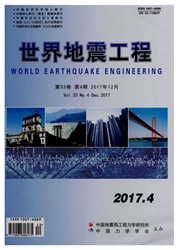

 中文摘要:
中文摘要:
随机有限断层法目前被广泛应用于近场地震动的模拟。针对基于现有的随机有限断层法合成得到的加速度时程,其能量存在明显的低频“下沉”这种不合理现象,以美国北岭地震的近场基岩记录资料及震源模型资料为依据,通过计算并对比分析实际记录时程和基于现有随机有限断层法模拟时程的能量在频域的累积分布曲线,揭示模拟时程的能量在频域的分布规律与记录时程的差异性,提出一种基于能量的改进随机有限断层法。利用汶川地震的记录资料及震源模型资料,对所提改进方法进行了合理性和有效性的论证。经过对比分析表明:基于能量的改进随机有限断层法合成得到的加速度时程,无论是能量在频域的分布规律还是反应谱随周期的变化规律,均表现为比改进前的方法得到的时程的对应值要更为接近于记录值,说明所提的改进方法具有一定的合理性和有效性。
 英文摘要:
英文摘要:
Stochastic finite-fault method now is widely used to simulate near-field ground motion. This paper aim to the synthesized acceleration time history by existed stoehastie finite-fault method, whose energy at lower frequency has an obviously ' sag'. Based on near-field record data on bedrock and source model of Northridge earthquake of America, the energy accumulation curve of record time history and synthesized time history by stochastic finite-fauh method is investigated to reveal the difference law of energy distribution between record and synthesized time history, then an improved method for stochastic finite-fanh method based on energy is propose. The record data and source model of Wenchuan earthquake are used to verify the rational and validity of the proposed method. Comparison and analyzing shows that acceleration from stochastic finite-fault method based on energy, which change laws of energy accumulation distribution curve in frequency domain and laws of response spectrum in period are both more close to the record than original method. So the results confirmed the rationality and validity of the improved method
 同期刊论文项目
同期刊论文项目
 同项目期刊论文
同项目期刊论文
 期刊信息
期刊信息
